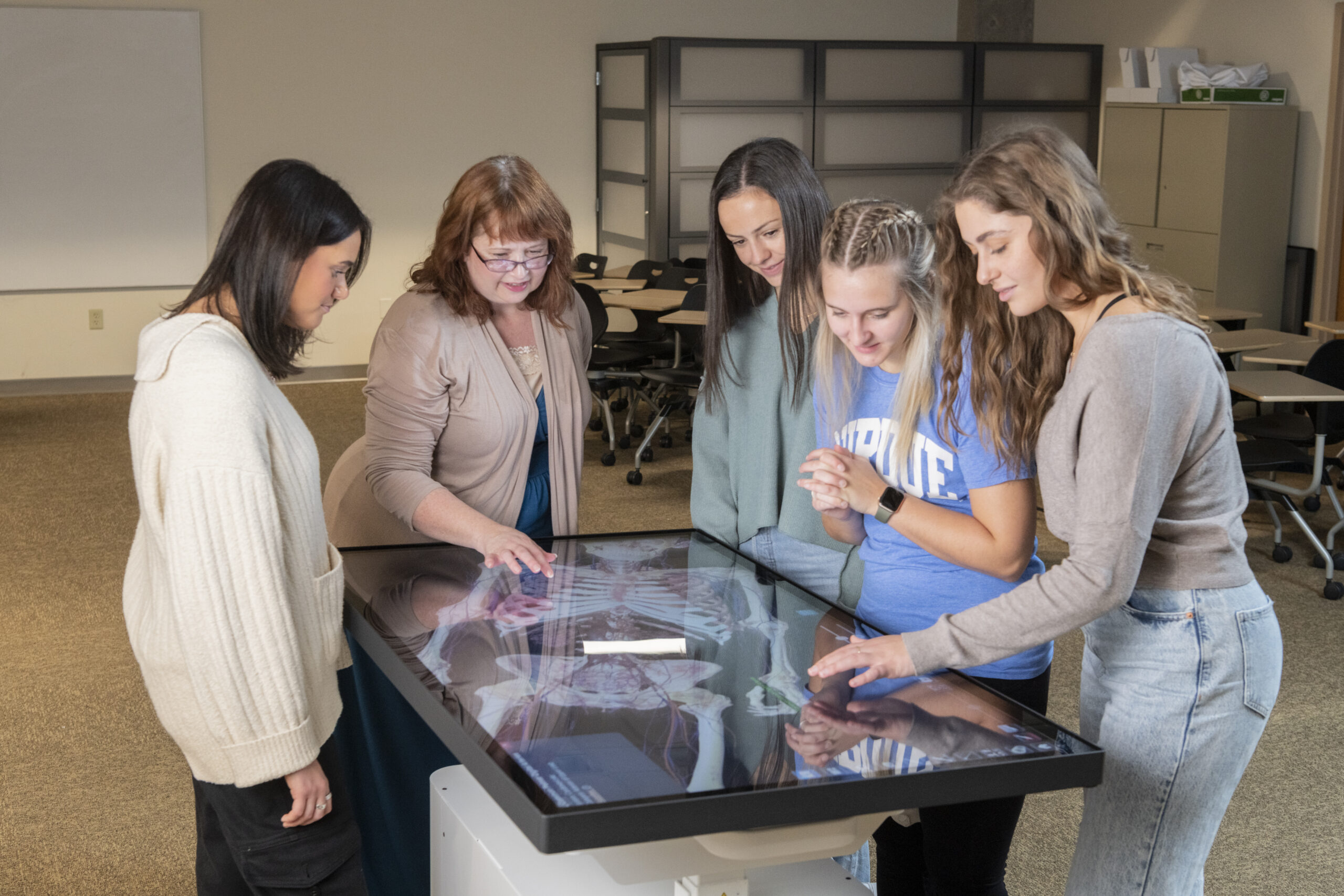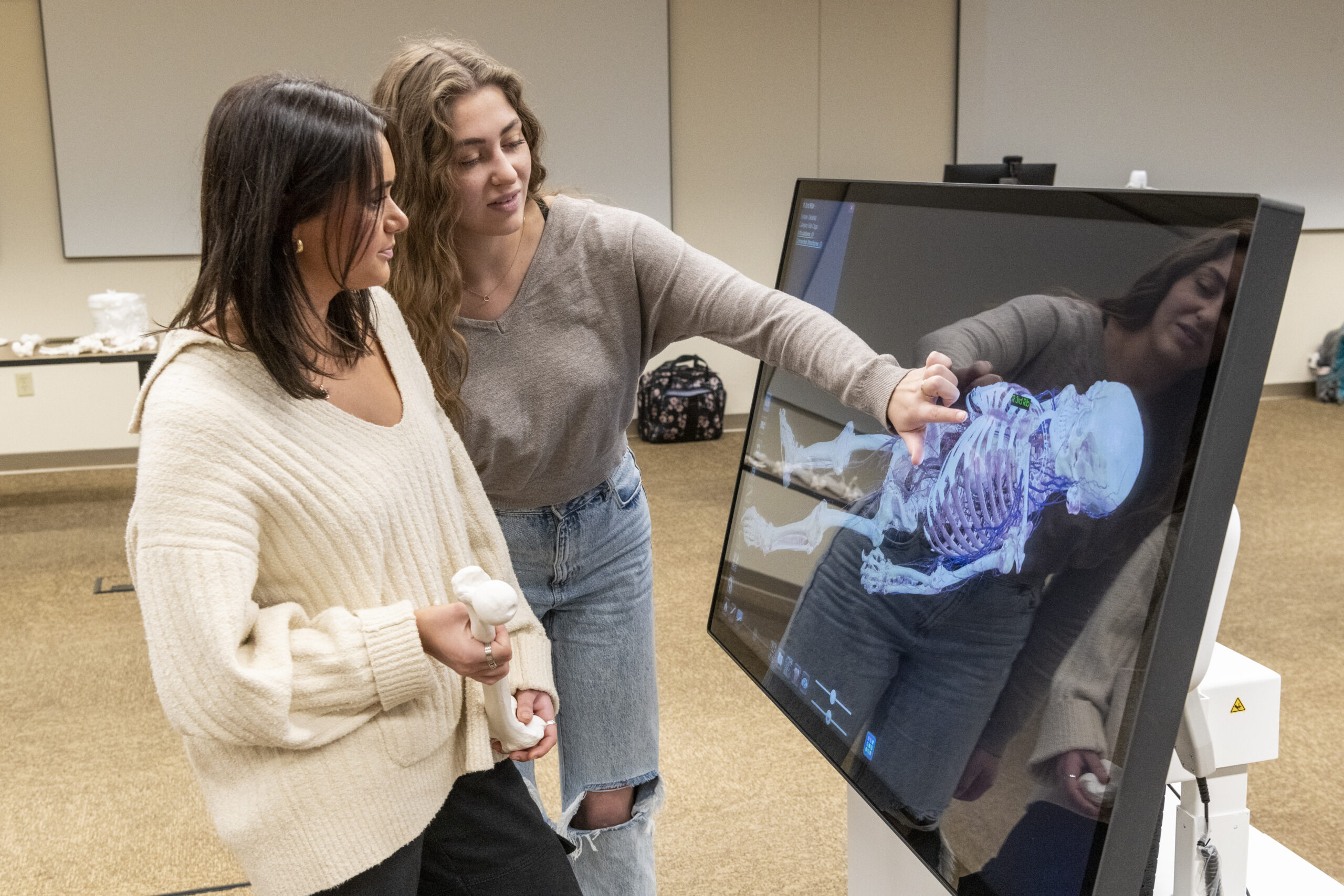Health Sciences anatomy class offers undergrads the next best thing to cadavers

Health Sciences Clinical Assistant Professor Lisa Hilliard, second from left, shows some of her Applied Anatomy for Medicine students how to operate an Anatomage Clinical Table.John Underwood
Written by: Tim Brouk, tbrouk@purdue.edu
The next best thing to real human cadavers rolled into the Purdue University College of Health and Human Sciences this fall.
Funded by a Purdue University Office of the Provost Instructional Equipment Grant, Lisa Hilliard, clinical assistant professor in the School of Health Sciences, and Scott Lawrance, clinical professor in the Department of Health and Kinesiology, invested in the future of their students — Hilliard in HSCI 42000 (Applied Anatomy for Medicine) class and Lawrance in HK 30200 (Applied Clinical Anatomy) and the Masters of Science in Athletic Training program — invested in the future of their students by purchasing two Anatomage Clinical Tables, an adjustable table-sized digital touchscreen interface that brings the human body to life in remarkable detail. These innovative, interactive pieces of equipment showcase the human form and each of its systems in their entirety.
Drawings in textbooks, PowerPoint presentations and online videos combined don’t come close to the level of real-time anatomic data students get to explore through the tables during class time. With just a few taps of the screen, students can examine not only the features of the skeletal, muscular and nervous systems but also the interaction between them in detail. The brilliant images were sourced from real cadavers — sliced, scanned and rebuilt using sophisticated graphic technology.
“These are virtual, dissectible humans (cadavers),” Hilliard said. “These tables are now being used in a lot of medical schools and professional programs. Having students enrich their contextual knowledge of anatomy through weekly exposure to these tables gives them deeper insight during our clinical discussions and an advantage as they transition to postgraduate programs.”
Lawrance’s athletic training students benefit greatly from the tables as well.
“Our athletic training students interact with anatomy in nearly every class they take here,” he explained, “so having access to this type of technology will enhance what we are able to do with our students and give them a better understanding of anatomy and pathoanatomy as they work with injured patients.”
Hilliard’s classroom in Hicks Undergraduate Library contains desks on wheels so her 72 students can move around to work in small groups. Throughout the class, the groups take turns utilizing the Anatomage Tables, exploring and looking at the real human form. With a few simple taps, students can remove skin, expose the cardiovascular and nervous systems, or remove muscles one at a time to reveal deeper layers.
Better than the real thing?
Manipulating full human cadavers each week in Hillard’s class isn’t feasible, especially since her assigned classroom is a university-controlled shared space. Even in a traditional lab setting, cadavers are cumbersome, noxious, laden with chemicals and expensive, costing around $3,000 per body, according to Hilliard.
“They’re hazardous, of course, because of those chemicals,” she explained. “Yet the upfront investment does not capture all the other linked operational cost. Once dissected, their user value is negligible, making obtaining new specimens necessary. In turn, these tables have a long-term life span, extending their impact beyond just a single use, which makes them extremely valuable.”
And unlike cadavers, there’s no refrigeration required to store these tables. A classroom closet was constructed by Hilliard with the support of campus planning, physical facilities, libraries and two HHS departments to secure and store the expensive technology and facilitate weekly use. The tables are wheeled out and set up within 40 minutes prior to students entering the classroom.
One of Hilliard’s favorite features of the tables is being able to make muscles invisible to expose how all the anatomical tissues interact with one another.
“Students really garner an appreciation for and understanding of the relationship and intimate connection between form and function through their engagement with these tools, which is imperative when you’re talking about the clinical application of anatomy in the care of human patients and their ever-changing forms,” she said.
Future PAs

Health Sciences seniors Julia Rechtzigel, left, and Lauren Willis work with an Anatomage Clinical Table before class. Both plan on pursuing careers as physician assistants.John Underwood
The tables were brought in at the beginning of the fall semester, so every student was able to see, move and zoom in on segments of the back, arms, shoulders and other areas of the body. With many of them aiming for medical or physician assistant schools and programs, the Anatomage Tables quickly became a valuable tool among the undergrads.
Seniors in the School of Health Sciences, Julia Rechtzigel and Lauren Willis both have physician assistant career goals. The Anatomage Tables have been a semester highlight for them.
“I’ll be using real-life cadavers, so this is a really nice step in the direction of doing that,” Rechtzigel said. “It’s nice to be able to spin around the body and be able to remove layers —super fun, super helpful. It’s helped me learn a lot.”
Willis was initially impressed by the tables’ almost sci-fi movie-level technology. She said she and her fellow undergraduates are lucky to get hands-on experience with the tables throughout the course.
“I haven’t had this in any other classes at Purdue,” Willis said. “This exact thing will obviously be included in my further curriculum. This is taking me in the right direction. It’s really great to build this knowledge before grad school. This absolutely is going to be helpful.”
Discover more from News | College of Health and Human Sciences
Subscribe to get the latest posts sent to your email.